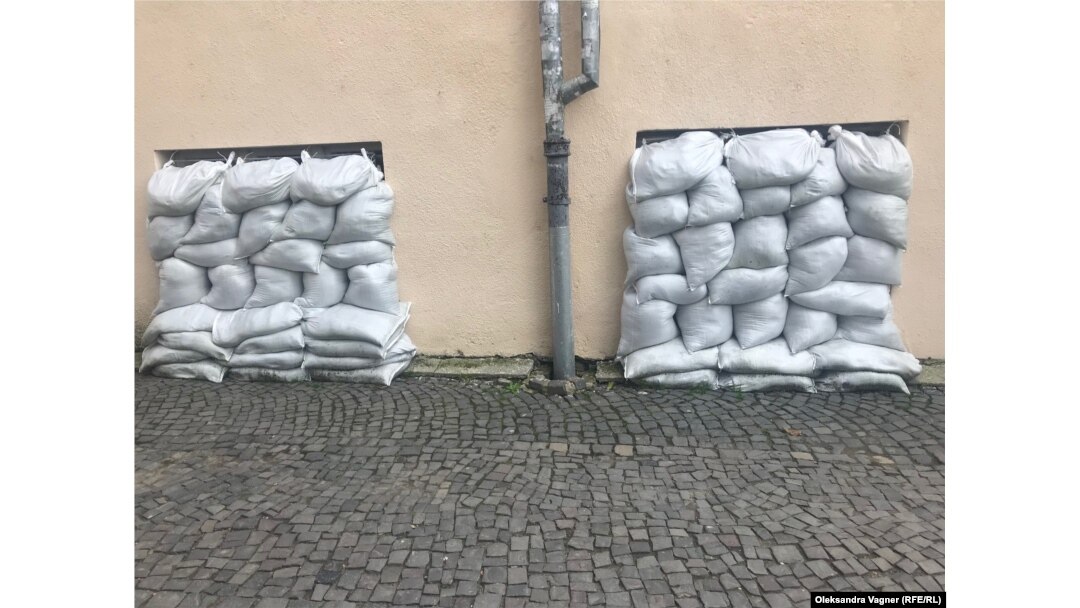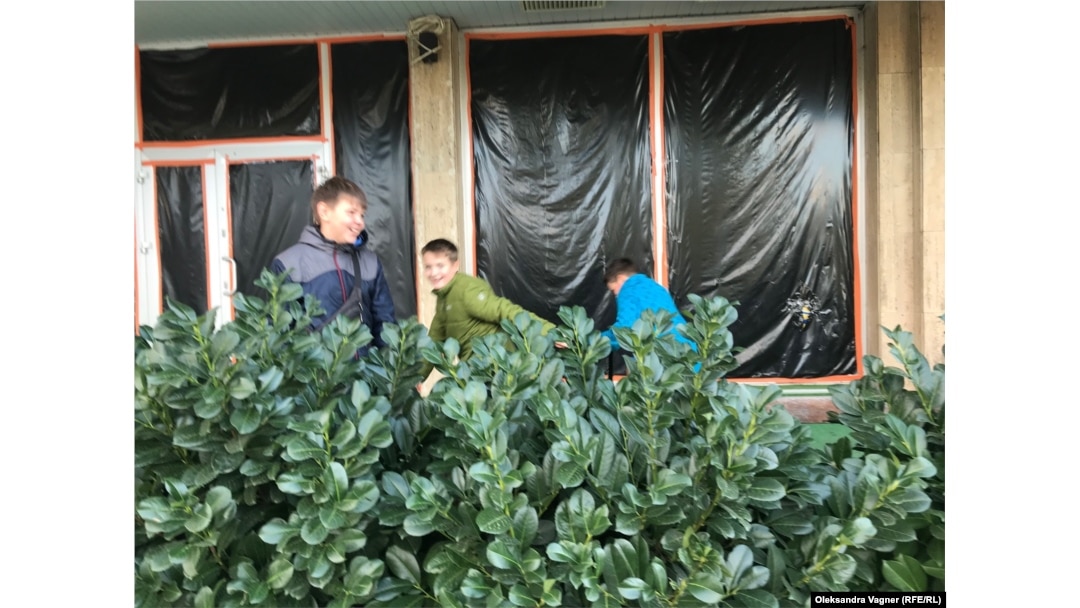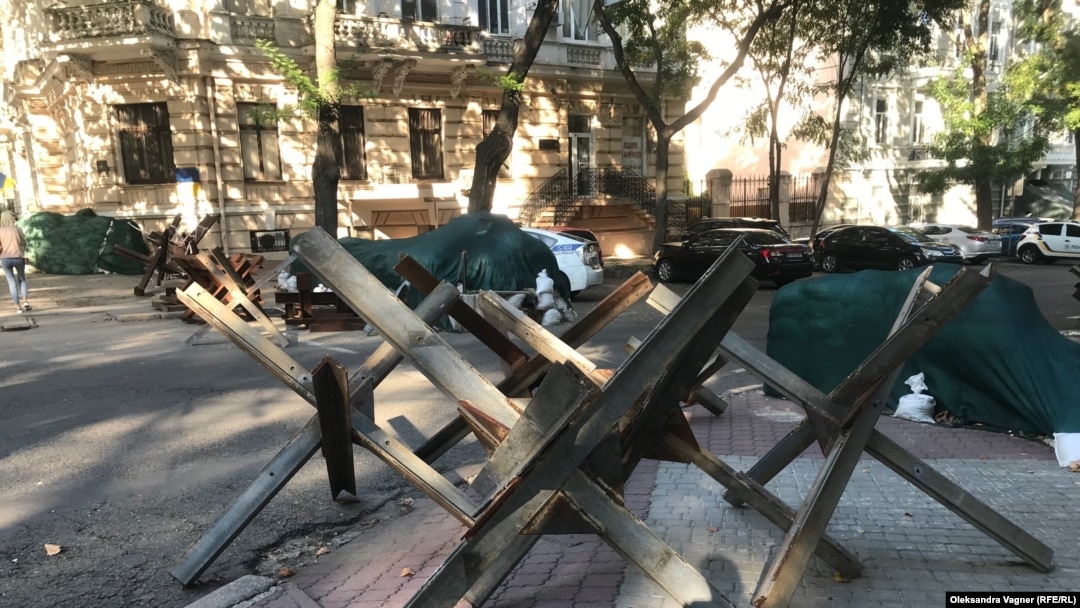RFE/RL's Russian Service correspondent Oleksandra Vagner witnessed drone strikes and the quiet determination of ordinary Ukrainians while travelling by train from western Ukraine to the port city of Odesa.
On the bus across the Slovakia-Ukraine border, the war is felt immediately -- on board there are only women. Men rarely traverse this border due to the martial law introduced back in February that banned most males from leaving Ukraine. During the ride, news arrives that the city of Lyman in eastern Ukraine has been recaptured. "So Syevyerodonetsk is next," some passengers declare hopefully as they celebrate.

Sandbags in the windows of a government building in Uzhhorod
Ukraine's western Zakarpattya region is the only part of Ukraine not locked down with evening curfews but even here, Russian missiles have arrived -- most recently in May. In Uzhhorod, the main city of the region, the changes wrought by war are clear. In the 14-story Intourist-Zakarpattya hotel only one floor is reserved for short stays, the rest of the rooms are occupied mostly by residents who fled Kharkiv.
The internally displaced children have online classes and in their free time run along the granite steps of the hotel, ride bicycles in the park, and make keychains in the colors of the Ukrainian flag. The day after I check in I meet Misha, a boy whose house was shelled on the first day of the invasion. When he recalls the rockets that hit his hometown, he looks up into the clear blue sky as if afraid that his words might conjure them up once more.

Misha (left) plays with other children from Kharkiv near a hotel in Uzhhorod, which has become their temporary home.
On the street in Uzhhorod, as well as Ukrainian, Russian is widely heard, as are Slovak and Hungarian. Ethnic Hungarian traders I meet in the market claim to know Ukrainian only poorly. "What do I think about the war?" one told me in good Ukrainian. "We will win!... We are all worried -- for our state, for people, for everyone," he said. "We have peace here, thank God."
A sign in a shop window in Uzhhorod: "We are working for you and for the recovery of our country's economy."
Everyone emphasizes their relief that the war has left them relatively unscathed, so problems, even biting economic issues, they believe are not worth mentioning. "They scare us with the cold winter approaching -- it's OK, we'll survive. Our people are patient," a trader tells me.
But Uzhhorod locals are also dying at the distant front lines. On one central street there is a banner in memory of the deceased Vadym Hubanov.
A billboard in memory of Ukrainian fighter Vadym Hubanov in Uzhhorod
Red arrows pointing to the locations of bomb shelters are visible everywhere. But despite the military threat, the restoration of frescoes in the local Greek Catholic cathedral continues. The restoration of the cathedral is funded by Hungary, Romania, and Slovakia as part of an EU program. Against the backdrop of churches and museums destroyed by Russian shelling, it's heartening to watch the restoration of Ukrainian cultural heritage continuing.
The remains of a Tochka-U missile, which the Russian military used on a Ukrainian city. The wreckage, along with other Russian weapons used in Ukraine, is on display in the courtyard of the Uzhhorod castle.
In Uzhhorod, local monuments as well as languages reflect the complex history of this region. The great poets Sandor Petofi of Hungary and Taras Shevchenko of Ukraine are represented, but a monument to Russia's Aleksandr Pushkin was removed after the invasion. Neatly written graffiti on the empty plinth suggest a monument to French singer Joe Dassin may take his place. Dassin's grandparents hailed from Odesa, in today's Ukraine.
The monument to Pushkin was dismantled in May.
Ivan Hryhoriyevich, an employee at the Transcarpathian Regional Artistic Museum, told me: "We have Slovaks, Hungarians, Czechs living here. And now people say, [controversial Ukrainian nationalist icon] Stepan Bandera's here!
"Those who come from the east, from the Donetsk and Luhansk regions, are migrants. I ask them, 'Are you okay here?' They answer, 'We're fine, we already want to buy an apartment.' Then I ask, 'Are you not afraid of Bandera?' After all, they were intimidated by all the nationalists! Propaganda, unfortunately -- I still can't believe it's possible to be so brainwashed."
"Of course, I am a patriot of Ukraine," he tells me, "but I don't like all this traditional Ukrainian clothing for show. You have to be Ukrainian in your soul."
A child's painting, No To War, at an exhibition in Uzhhorod
Seventy-three-year-old Hryhoriyevich lived and travelled in the Soviet Union. "Look how much territory Russia has," he said. "I was once in the Tyumen region -- it's empty, there's no one. How much more land do they need? I swear to you, if I were younger, I would go to the front myself, I served and I know how to hold a machine gun."
The elderly museum worker finishes speaking and points me toward the staircase: There are empty pedestals but no exhibits. Because of the war, the museum's treasures were hidden in a place safe from the bombing.
Exhibits at the beginning of the war were evacuated from museums throughout Ukraine. Many museums were closed and will reopen only after the conflict ends.
At the Uzhhorod railway station it is immediately clear from the schedule board where the heavy fighting is taking place: trains to Kherson and Kharkiv have been canceled. The way to Odessa by train remains open but the compartment windows are sealed with a thick layer of adhesive tape to prevent being blasted into deadly fragments by shelling.
On the day of my arrival in Odesa, an air-raid siren howls across the city, followed by powerful explosions on the outskirts. I ask a woman at a tram stop what best to do. "Hide," she tells me calmly, "The tram is coming, get in and go home."
Adhesive tape on windows in Odesa
Elina Aleksandrovna, a retired therapist from Odesa, recalls the day the invasion was launched. "Our war began with two explosions. Some people heard them early in the morning, but I didn't," she said. "And then it rumbled mightily." Now, she said, "it rumbles all the time."
"No one needs this war. It stole everything from us, everything we had. I imagine that someday [Ukrainian and Russian Presidents] Zelensky and Putin will sign something so that it all ends sooner," she said.
"I want people to stop shooting and live peacefully as usual. So that they go to work, so that there is no curfew, so that they live not with war, but with their daily worries and affairs, so that they can plan something and don't have to run for the last tram at 10 because of the 11 p.m. curfew. It's impossible to live like this. Perhaps war for Russia is the norm, but not for us."
During the several days I stay in Odesa, I don't see children on the streets even once. Staying here under nearly constant shelling is too dangerous.
On Odesa's picturesque coastline it immediately becomes clear that the UN-backed deal to maintain a safe shipping passage for grain exports is not observed by Russia. Drones buzz along the coast, which is why no one here considers strolls along the embankment, and the famous Potemkin Stairs are now closed to all but military personnel.
Smoke in the sky above Odesa after a rocket destroys a Russian drone
From October 9 to 10, air-raid sirens howled throughout the night and in the morning explosions began.
On October 10, a drone was shot down in front of my eyes as I watched from the apartment where I was staying. The drone flew in from the sea and appeared to be heading toward residential high-rise buildings.
Monuments of the Soviet era remain in Odesa despite the decommunization laws adopted in Ukraine after the 2014 annexation of Crimea and war in the Donbas. The image of Vladimir Lenin on Odesa's Wings of Victory monument was repaired recently using public funds, despite the fact that many elegant facades of Art Nouveau buildings era in the city center remain in terrible condition.
Odesa's Sofiyivska Street, named after the wife of a pro-Russian historical figure, has not yet been renamed, but local residents painted over its name.
While I was in Odesa, a petition to President Volodymyr Zelensky over recent actions by Mayor Hennadiy Trukhanov gained 25,000 signatures. The authors of the petition claimed Trukhanov is "loyal to the invaders" and called attention to what they claim are his pro-Russian views.
One of the manifestations of this is the controversy around a monument depicting Russian Tsarina Catherine II. Now it is doused with paint and wrapped in blue tape, a marker used by Ukrainian soldiers to visually identify themselves.
The restored Founders Of Odesa monument was re-erected here in 2007, nearly a century after the original was torn down in 1920. Many politicians opposed the restoration of the monument topped with the Russian empress, even before the start of the current war.
The monument to the Founders of Odesa that was restored in the 2000s.
Disputes over monuments broke out anew in Odesa after Russia's February invasion, when people began to die under Russian missiles. The death of a 3-month-old girl during a rocket attack on April 24 is remembered here every time the conversation turns to hostilities. The house where the girl died has already been restored, but as locals emphasize, her life cannot be returned.
In April, Odesa's Tairov cemetery was hit by a fragment of a Russian missile, but when I arrive by taxi I find all the damage has been repaired. The taxi driver who takes me there tells me: "This is not a military action, but genocide -- everything has been destroyed. Every day I have passengers from Kherson, Mykolayiv, they move here and live. Some rent apartments, others live in a hostel. But everyone wants to go home."


